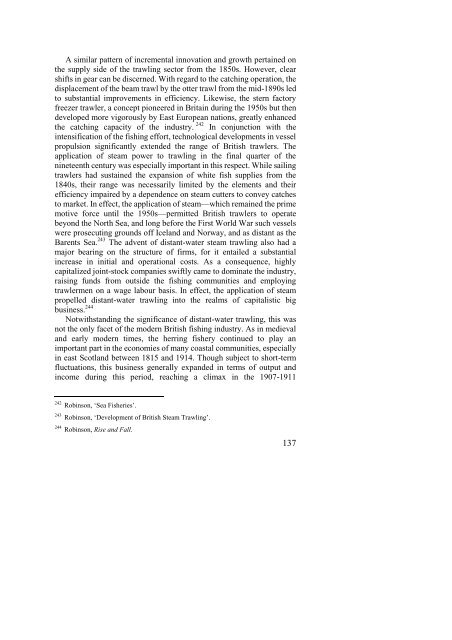The North Atlantic Fisheries, 1100-1976 - University of Hull
The North Atlantic Fisheries, 1100-1976 - University of Hull
The North Atlantic Fisheries, 1100-1976 - University of Hull
Create successful ePaper yourself
Turn your PDF publications into a flip-book with our unique Google optimized e-Paper software.
A similar pattern <strong>of</strong> incremental innovation and growth pertained on<br />
the supply side <strong>of</strong> the trawling sector from the 1850s. However, clear<br />
shifts in gear can be discerned. With regard to the catching operation, the<br />
displacement <strong>of</strong> the beam trawl by the otter trawl from the mid-1890s led<br />
to substantial improvements in efficiency. Likewise, the stern factory<br />
freezer trawler, a concept pioneered in Britain during the 1950s but then<br />
developed more vigorously by East European nations, greatly enhanced<br />
the catching capacity <strong>of</strong> the industry. 242 In conjunction with the<br />
intensification <strong>of</strong> the fishing effort, technological developments in vessel<br />
propulsion significantly extended the range <strong>of</strong> British trawlers. <strong>The</strong><br />
application <strong>of</strong> steam power to trawling in the final quarter <strong>of</strong> the<br />
nineteenth century was especially important in this respect. While sailing<br />
trawlers had sustained the expansion <strong>of</strong> white fish supplies from the<br />
1840s, their range was necessarily limited by the elements and their<br />
efficiency impaired by a dependence on steam cutters to convey catches<br />
to market. In effect, the application <strong>of</strong> steam—which remained the prime<br />
motive force until the 1950s—permitted British trawlers to operate<br />
beyond the <strong>North</strong> Sea, and long before the First World War such vessels<br />
were prosecuting grounds <strong>of</strong>f Iceland and Norway, and as distant as the<br />
Barents Sea. 243 <strong>The</strong> advent <strong>of</strong> distant-water steam trawling also had a<br />
major bearing on the structure <strong>of</strong> firms, for it entailed a substantial<br />
increase in initial and operational costs. As a consequence, highly<br />
capitalized joint-stock companies swiftly came to dominate the industry,<br />
raising funds from outside the fishing communities and employing<br />
trawlermen on a wage labour basis. In effect, the application <strong>of</strong> steam<br />
propelled distant-water trawling into the realms <strong>of</strong> capitalistic big<br />
business. 244<br />
Notwithstanding the significance <strong>of</strong> distant-water trawling, this was<br />
not the only facet <strong>of</strong> the modern British fishing industry. As in medieval<br />
and early modern times, the herring fishery continued to play an<br />
important part in the economies <strong>of</strong> many coastal communities, especially<br />
in east Scotland between 1815 and 1914. Though subject to short-term<br />
fluctuations, this business generally expanded in terms <strong>of</strong> output and<br />
income during this period, reaching a climax in the 1907-1911<br />
242 Robinson, ‘Sea <strong>Fisheries</strong>’.<br />
243 Robinson, ‘Development <strong>of</strong> British Steam Trawling’.<br />
244 Robinson, Rise and Fall.<br />
137















